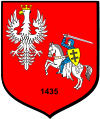 Alternate names: Błażowa [Pol], Blazhova [Yid], Blezov, Bluzhov, בלאז'ובה-Hebrew, Blazev, Blazow, Blazhowa, Blażowa Dolna, Bluzhow, Bluzhov. 49°53' N, 22°06' E, 12 miles SSE of Rzeszów. Słownik Geograficzny Królestwa Polskiego (1880-1902), I, p. 246: "Błażowa". Shtetlink. Błażowa is the seat of the Gmina [Rural Administrative District] that includes the city and commune of Błażowa and villages / communities: Białka, Błażowa Dolna, Futoma, Kąkolówka, Lecka, Nowy Borek, Piatkowa. On June 26, 1941, the Jews of Błażowa remaining were forcibly moved to Rzeszów Ghetto with Jews from nearby villages. Some were shot in Rzeszów, others deported to forced-labor camps or shot in Glogów Forest, and other transported to Belzec extermination camp (July 7-18, 1942) to be gassed upon arrival. 2006 population: 2,110. [March 2009]
Alternate names: Błażowa [Pol], Blazhova [Yid], Blezov, Bluzhov, בלאז'ובה-Hebrew, Blazev, Blazow, Blazhowa, Blażowa Dolna, Bluzhow, Bluzhov. 49°53' N, 22°06' E, 12 miles SSE of Rzeszów. Słownik Geograficzny Królestwa Polskiego (1880-1902), I, p. 246: "Błażowa". Shtetlink. Błażowa is the seat of the Gmina [Rural Administrative District] that includes the city and commune of Błażowa and villages / communities: Białka, Błażowa Dolna, Futoma, Kąkolówka, Lecka, Nowy Borek, Piatkowa. On June 26, 1941, the Jews of Błażowa remaining were forcibly moved to Rzeszów Ghetto with Jews from nearby villages. Some were shot in Rzeszów, others deported to forced-labor camps or shot in Glogów Forest, and other transported to Belzec extermination camp (July 7-18, 1942) to be gassed upon arrival. 2006 population: 2,110. [March 2009]
CEMETERY: photos [April 2009]
US Commission No. POCE000490
Ksiedza Pilipca Street. 1992 town population is 1,000-5,000 with no Jews.
-
- Local: Urzad Miasta i Gminy, Wolnosci Sq. 1, 36- 030 Blazowa, tel. 119.
- Regional: Wojewodzki Konserwator Zabtkow, ulica Grunwaldzwa 7, Rzeszow.
The earliest known Jewish community is 17th century. In 1939, there were 500 to 800 Jews. The unlandmarked Orthodox and Progressive/Reform cemetery was established in 18th century, about 1 km from synagogue. The last known burial was during WWII. Between fields and wood, the isolated crown of a hill has no sign or marker. Reached by crossing private property, access is open to all via broken masonry wall and a broken fence with no gate. Before WWII and now, the size is 700 sq.m. 20 to 100 gravestones remain in original location with 25-50% toppled or broken. Vegetation overgrowth is a constant problem disturbing stones and graves. The 19th and 20th century limestone, sandstone, or slate either rough stones/boulders or flat-shaped stones have Hebrew and Polish inscriptions. Site contains no known mass graves. The municipality owns the property used as a Jewish cemetery only. Adjacent property is agricultural. Rarely, private visitors stop. It was vandalized during World War II and occasionally since. No care. Within the limits of the cemetery are no structures. Security and vandalism are a very serious threat. Vegetation is a moderate threat. Weather erosion is a slight threat.
Natascha Rode, 35-213 Rzeszow, ulica Starzynskiego 5/29 completed survey in June, 1992 after a visit to the site in March, 1992. She conducted interviews.
